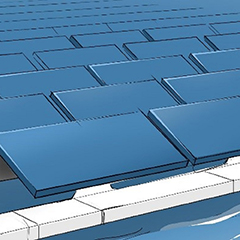Floating photovoltaic power plants can contribute to the expansion of renewable energy without taking up land. The Fraunhofer Institute for Solar Energy Systems ISE, RWE Renewables and the Brandenburg University of Technology Cottbus-Senftenberg (BTU) are working together to further develop this innovative technology with other partners. In the joint research project PV2Float, the partners are to test several floating PV systems with different structure designs under real conditions over a three-year period. An Evaluation for a suitable open pit lake for the implementation is currently ongoing.
Floating PV systems are installed on open water surfaces. They offer potential for renewable power generation and climate protection, and the technology hasn’t been widely adopted yet. In contrast to conventional ground-mounted systems, the PV modules are mounted on floats or membranes, which are put out on bodies of still open water and on the sea. In Germany alone there are about 500 open pit lakes, leftover from lignite open cast mining. According to Fraunhofer ISE, the potential of these open pit lakes from a purely technical standpoint is in the mid double-digit gigawatt range. Thus, floating PV opens up new applications for these former mines in locations such as Lusatia in the east of Germany. The aim of the PV2Float project, funded by the German Federal Ministry for Economic Affairs and Energy, is to develop the potential of this technology. The power plants installed and tested in this project form an important basis for the research work, with which a precise analysis of the technical requirements, economic efficiency and the ecological effects of floating PV power plants in Germany will be carried out. Acceptance of the new technology will also be investigated.
In addition to selecting the location of the site, the project partner RWE will carry out a comprehensive potential analysis of the German and international market for floating PV. As one of the world’s leading renewable energy companies, RWE has many years of experience in the construction and operation of ground-mounted PV plants. Currently the company is implementing a floating PV project in the Netherlands. Thorsten Miltkau, Senior Manager Solar Power at RWE renewables explains: “We see great potential for floating PV worldwide. With this research project, we want to deepen our knowledge of the technical possibilities of floating PV systems, such as scalability and energy yield, and transfer the findings to commercial projects.”
The demonstration PV plant is to be designed and built together with Volta Solar. Four floating PV installations and a reference installation on land with a total power of around 150 kilowatts are planned. Heckert Solar, a solar module manufacturer in Chemnitz, will support the project with innovative PV module concepts.
VDE Renewables is evaluating the developed power plant concepts to ensure that they comply with standards and electrical safety. They will also inspect the plants after construction. Fraunhofer ISE will investigate the regulatory framework for floating PV plants and is also developing a procedure for the participation of local stakeholders. Additionally, the institute will perform durability tests on the individual system components, further develop PV modules as well as simulation models on energy yield, adapting them to meet the particular requirements of floating applications, where necessary. The researchers at Fraunhofer ISE will also investigate the economic viability of floating PV. Stefan Wieland, project head at Fraunhofer ISE, says: “Bodies of water put special demands on the design, material, environmental compatibility and operational management of floating PV power plants. In the project, these aspects are investigated for large floating PV plants.” The aquatic ecology monitoring is the responsibility of BTU Cottbus-Senftenberg and the Institut für Wasser und Boden Dr. Uhlmann in Dresden.






























